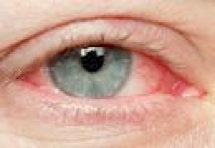Eye Conditions

Eye Conditions Farmworkers are at particular risk for a number of eye injuries and conditions, due to their working environment. Recent studies have found elevated rates of eye conditions compared to other industries. See Eye Health and Safety Among Latino Farmworkers, by A. Verma, and colleagues.
Effects of sunlight, wind and dust– Research indicates high rates of pain, redness, itching and blurred vision among farmworkers, largely due to extended periods of time spent working in sun, wind and dust. Short-term conditions that may result from these exposures include eye irritation and eye sensitivity, while long-term conditions include cataract formation, retinal damage, and pterygium. One intervention study in New York State found that with use of protective eyewear and a sterile saline solution eye wash, farmworker eye symptoms were significantly reduced (May, unpublished). The following eye conditions have also been identified as occurring frequently among farmworkers:
- Dry eye – This is a common eye condition that occurs when a person does not produce enough tears to keep the eyes wet and comfortable. The eye has a tear film that coats the eye’s outer layer. New tears form in glands located around the eye and they keep the moisture level in the eye balanced. This protective film is important for comfort and clear vision. Dry eye results from a variety of causes, but aging is the single most common factor. See Dry Eye, by Penn Eye Care, Scheie Eye Institute.
- Pterygium (conjunctiva) is a benign growth of the conjunctiva. It is associated with, and thought to be caused by ultraviolet-light exposure (e.g., sunlight), wind, low humidity, and dust. The exact cause is unknown, but it is associated with excessive exposure to wind, sunlight, or sand. It has been commonly observed among farmworkers in several regions and often affects both eyes. See Pterygium, by D. Jacobs, UpToDate.
- Cataracts – Cataracts are most commonly age-related, however they also can be caused by trauma, diabetes, systemic steroids or excessive sun exposure. With aging, protein fibres in the lens break down and clump. The resulting lenticular opacities affect both visual acuity and color perception. Victims can be particularly sensitive to lighting conditions. Diet, smoking and use of UV-protective eyewear can affect risk of cataract. Together, blocking some of the light that would normally enter through the lens so that the patient’s distance vision becomes duller and cloudier. The lens may turn yellowish or brown, making it harder to read and distinguish dark colours such as dark blue and purple. Eating a healthy diet, quitting smoking and protecting the eyes from bright sunlight may delay or reduce the risk of developing age-related cataracts. A traumatic cataract may occur as a result of a blunt force injury that directly damages the lens, or can result from a penetrating injury, in which the eye is pierced by a sharp object. A traumatic cataract may form soon after an injury or months to years later. Prolonged exposure to ultraviolet radiation (UV) from sunlight is another cause of cataracts.
- Allergic reactions to natural substances– The farm environment contains a wide range of natural allergens, including organic components of dust, mold, grasses, and insects. Farmworkers are at increased risk of sensitization to these allergens due to continued exposure while working in these environments. Housing conditions may contribute due to, and also when housing conditions include crowded conditions, water damage, presence of insects and other pests and excessive humidity control. One of the main difficulties associated with this condition is the difficulty in distinguishing it from a reaction to agricultural or household chemicals, which can produce very similar symptoms. When the eyes are affected, differentiating between irritation due to allergic sensitization and irritation related to chemical exposures on the farm requires a detailed exposure history, as well as consideration of the timing of symptoms.
- Reactions to chemical contact – Eye irritation may result from exposure to agricultural pesticides (Lacey et al. 2007; Weinbaum et al., 1995). The frequent use of pesticides and herbicides in farming can expose workers’ eyes through nebulized mists or direct contact by contaminated fingers. Some of the worst injuries are chemical burns from alkalis, which are heavily used in fertilizers, in cleaning agents and in adjusting pH in canning operations. With their high pH, these agents can burn through the surface of the cornea. Data from pesticide applicators in North Carolina and Iowa suggest that several types of fungicides are related to retinal degeneration (Kirrane 2005). Other research indicates that organophospates have an effect ranging from the lens to the retina (Dementi, 1994).
Eye trauma –
Abrasions to the eye may follow contact with thorns, stalks, vines, and bushes. Additionally, farmworkers are sometimes exposed because appropriate shielding has been removed. Case reports have documented failure of hydraulic lines on tractors resulting in workers being sprayed in the eyes with hydraulic fluid or other chemicals (Lacey et al. 2007)
Penetrating trauma – One recent large study identified metal foreign bodies in the eye as the leading type of agricultural eye injury, although a wide variety of other objects (including tree branches and plant material) are frequently involved in eye trauma. Sometimes penetrating foreign bodies enter the eye without producing significant physical findings. Clinical Update: Trauma, Managing Agricultural and Industrial Eye Injuries, by A. Stuart, EyeNet.
Poor vision – Studies have shown high rates of uncorrected vision problems among farmworkers, resulting from poor access to eye care and other factors. Uncorrected eyesight can lead to traumatic injury, and affect workers ability to perform job tasks effectively.
Further Farmworker eye condition diagnosis and treatment links:
- Diagnosis and Management of Red Eye in Primary Care, by H. Cronau and colleagues, Am. Fam. Physician.
Farmworker prevention and education links:
- NYCAMH prevent injuries to your eyes
- NYCAMH Dust Masks (English) and NYCAMH Máscaras contra polvo (Spanish)
- NYCAMH Personal Hygiene (English) and NYCAMH Higiene personal (Spanish)
- Rural Women’s Health Project eye health materials:
Back to Common Farmworker Health Conditions and Diagnostic Tools